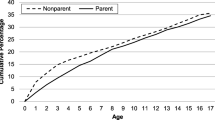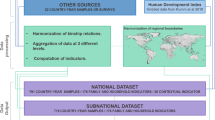Abstract
Previous descriptions of the composition and stability of children’s households have focused on the presence of parents and the stability of mothers’ marital and cohabiting relationships. We use data available in the 2008 Survey of Income and Program Participation to expand the description of children’s household composition and stability. We find that one in five children lives with nonnuclear household members. These other household members are a source of substantial household instability. In addition, during the period of observation (2008–2013), children experienced considerable residential instability. Thus, children’s experience of household instability is much more common and frequent than previously documented. Moreover, levels of both residential and compositional instability are higher for children with less-educated mothers and for racial/ethnic minorities.



Similar content being viewed by others
References
Amato, P. R. (2000). The consequences of divorce for adults and children. Journal of Marriage and the Family, 62, 1269–1287.
Amorim, M., Dunifon, R., & Pilkauskas, N. (2017). The magnitude and timing of grandparental coresidence during childhood in the United States. Demographic Research, 37, 1695–1706. https://doi.org/10.4054/DemRes.2017.37.52
Astone, N. M., & McLanahan, S. (1994). Family strucure, residential mobility, and school dropout: A research note. Demography, 31, 575–584.
Bitler, M., & Hoynes, H. (2015). Living arrangements, doubling up, and the Great Recession: Was this time different? American Economic Review: Papers and Proceedings, 105, 166–170.
Bloome, D. (2017). Childhood family structure and intergenerational income mobility in the United States. Demography, 54, 541–569.
Brown, S. L. (2006). Family structure transitions and adolescent well-being. Demography, 43, 447–461.
Brown, S. L., Stykes, J. B., & Manning, W. D. (2016). Trends in children’s family instability, 1995–2010. Journal of Marriage and Family, 78, 1173–1183.
Carroll, J. S., Olson, C. D., & Buckmiller, N. (2007). Family boundary ambiguity: A 30-year review of theory, research, and measurement. Family Relations, 56, 210–230.
Cavanagh, S. E., & Fomby, P. (Forthcoming). Family instability in the lives of American children. Annual Review of Sociology.
Cavanagh, S. E., & Huston, A. C. (2006). Family instability and children’s early problem behavior. Social Forces, 85, 551–581.
Cherlin, A., Cumberworth, E., Morgan, S. P., & Wimer, C. (2013). The effects of the Great Recession on family structure and fertility. Annals of the American Academy of Political and Social Science, 650, 214–231.
Cohen, P. N. (2014). Recession and divorce in the United States, 2008–2011. Population Research and Policy Review, 33, 615–628.
Coleman, M., Ganong, L., & Fine, M. (2000). Reinvestigating remarriage: Another decade of progress. Journal of Marriage and the Family, 62, 1288–1307.
Cross, C. J. (2018). Extended family households among children in the United States: Differences by race/ethnicity and socio-economic status. Population Studies, 72, 235–251.
Desmond, M. (2012). Eviction and the reproduction of urban poverty. American Journal of Sociology, 118, 88–133.
Desmond, M., Gershenson, C., & Kiviat, B. (2015). Forced relocation and residential instability among urban renters. Social Service Review, 89, 227–262.
Desmond, M., & Perkins, K. L. (2016). Housing and household instability. Urban Affairs Review, 52, 421–436.
Dreier, P., Mollenkopf, J., & Swanstrom, T. (Eds.). (2001). Place matters: Metropolitics for the twenty-first century. Lawrence: University of Kansas Press.
Duncan, B. (1967). Education and social background. American Journal of Sociology, 72, 363–372.
Fomby, P., & Cherlin, A. J. (2007). Family instability and child well-being. American Sociological Review, 72, 181–204.
Fomby, P., & Mollborn, S. (2017). Ecological instability and children’s classroom behavior in kindergarten. Demography, 54, 1627–1651.
Fomby, P., Mollborn, S., & Sennott, C. A. (2010). Race/ethnic differences in effects of family instability on adolescents’ risk behavior. Journal of Marriage and Family, 72, 234–253.
Fomby, P., & Sennott, C. A. (2013). Family structure instability and mobility: The consequences for adolescents’ problem behavior. Social Science Research, 42, 186–201.
Geist, C., & McManus, P. A. (2008). Geographical mobility over the life course: Motivations and implications. Population, Space and Place, 14, 283–303.
Gibson-Davis, C., & Rackin, H. (2014). Marriage or carriage? Trends in union context and birth type by education: Changing union context. Journal of Marriage and Family, 76, 506–519.
Glick, J. E., & Van Hook, J. (2011). Does a house divided stand? Kinship and the continuity of shared living arrangements. Journal of Marriage and Family, 73, 1149–1164.
Hauser, R. M., & Featherman, D. L. (1976). Equality of schooling: Trends and prospects. Sociology of Education, 49, 99–120.
Kamo, Y. (2000). Racial and ethnic differences in extended family households. Sociological Perspectives, 43, 211–229.
Kreider, R. M., & Ellis, R. R. (2011). Living arrangements of children: 2009 (Current Population Reports No. P70-125). Washington, DC: U.S. Census Bureau.
Lee, D., & McLanahan, S. (2015). Family structure transitions and child development: Instability, selection, and population heterogeneity. American Sociological Review, 80, 738–763.
Martin, S. P. (2006). Trends in marital dissolution by women’s education in the United States. Demographic Research, 15, 537–560. https://doi.org/10.4054/DemRes.2006.15.20
Martin, S. P., Astone, N. M., & Peters, H. E. (2014). Fewer marriages, more divergence: Marriage projections for millennials to age 40 (Report). Washington, DC: Urban Institute.
McLanahan, S. (2004). Diverging destinies: How children are faring under the second demographic transition. Demography, 41, 607–626.
McLanahan, S., & Sandefur, G. D. (1994). Growing up with a single parent: What hurts, what helps. Cambridge, MA: Harvard University Press.
McLanahan, S., Tach, L., & Schneider, D. (2013). The causal effects of father absence. Annual Review of Sociology, 39, 399–427.
Mykyta, L., & Macartney, S. (2012). Sharing a household: Household composition and economic well-being: 2007–2010 (Current Population Reports No. P60-242). Washington, DC: U.S. Census Bureau.
Osborne, C., & McLanahan, S. (2007). Partnership instability and child well-being. Journal of Marriage and Family, 69, 1065–1083.
Perkins, K. L. (2017). Household complexity and change among children in the United States, 1984 to 2010. Sociological Science, 4, 701–724.
Perkins, K. L. (2018, April). Compounded change: Residential mobility, changes in household composition, and children’s educational attainment. Paper presented at the annual meeting of the Population Association of America, Denver, CO.
Perkins, K. L. (2019). Changes in household composition and children’s educational attainment. Demography, 56, 525–548.
Pilkauskas, N. V. (2012). Three-generation family households: Differences by family structure at birth. Journal of Marriage and Family, 74, 931–943.
Pilkauskas, N. V., & Cross, C. (2018). Beyond the nuclear family: Trends in children living in shared households. Demography, 55, 2283–2297.
Pilkauskas, N. V., Garfinkel, I., & McLanahan, S. S. (2014). The prevalence and economic value of doubling up. Demography, 51, 1667–1676.
Rackin, H. M., & Gibson-Davis, C. M. (2018). Social class divergence in family transitions: The importance of cohabitation. Journal of Marriage and Family, 80, 1271–1286.
Raley, R. K., & Bumpass, L. L. (2003). The topography of the divorce pleateau: Levels and trends in union stability in the United States after 1980. Demographic Research, 8, 245–260. https://doi.org/10.4054/DemRes.2003.8.8
Raley, R. K., Sweeney, M. M., & Wondra, D. (2015). The growing racial and ethnic divide in U.S. marriage patterns. Future of Children, 25(2), 89–109.
Raley, R. K., & Wildsmith, E. (2004). Cohabitation and children’s family instability. Journal of Marriage and Family, 66, 210–219.
Reynolds, R., Raley, K., & Weiss, I. (2019). Household change with relationships [Texas Data Repository Dataverse, V1]. Retrieved from https://dataverse.tdl.org/dataset.xhtml?persistentId=doi:10.18738/T8/CAMJAL
Sarkisian, N., Gerena, M., & Gerstel, N. (2007). Extended family integration among Euro and Mexican Americans: Ethnicity, gender, and class. Journal of Marriage and Family, 69, 40–54.
Sharkey, P. (2008). The intergenerational transmission of context. American Journal of Sociology, 113, 931–969.
Stack, C. B., & Burton, L. M. (1993). Kinscripts. Journal of Comparative Family Studies, 24, 157–170.
Sweeney, M. M., & Raley, R. K. (2014). Race, ethnicity, and the changing context of childbearing in the United States. Annual Review of Sociology, 40, 539–558.
Turner, M. A., Ross, S., Galster, G., & Yinger, J. (2002). Discrimination in metropolitan housing markets (Report). Washington, DC: U.S. Department of Housing and Urban Development.
Van Hook, J., & Glick, J. E. (2007). Immigration and living arrangements: Moving beyond economic need versus acculturation. Demography, 44, 225–249.
Waldfogel, J., Craigie, T.-A., & Brooks-Gunn, J. (2010). Fragile Families and Child Wellbeing. Future of Children, 20(2), 87–112.
Wu, L. L., & Martinson, B. C. (1993). Family structure and the risk of a premarital birth. American Sociological Review, 58, 210–232.
Wu, L. L., & Thomson, E. (2001). Race differences in family experience and early sexual initiation: Dynamic models of family structure and family change. Journal of Marriage and Family, 63, 682–696.
Acknowledgments
This research benefited from comments by FAMDEM seminar participants, especially Abigail Weitzman and Alex Weinreb, PRC Brownbag participants, and the comments of anonymous reviewers. It was supported by Grants P2CHD042849, Population Research Center, awarded to the Population Research Center at The University of Texas at Austin; and R03HD090425, Children’s Family and Household Experiences (Raley PI) by the Eunice Kennedy Shriver National Institute of Child Health and Human Development. The content is solely the responsibility of the authors and does not necessarily represent the official views of the National Institutes of Health.
Author information
Authors and Affiliations
Corresponding author
Additional information
Publisher’s Note
Springer Nature remains neutral with regard to jurisdictional claims in published maps and institutional affiliations.
Electronic supplementary material
ESM 1
(ZIP 188 kb)
Rights and permissions
About this article
Cite this article
Raley, R.K., Weiss, I., Reynolds, R. et al. Estimating Children’s Household Instability Between Birth and Age 18 Using Longitudinal Household Roster Data. Demography 56, 1957–1973 (2019). https://doi.org/10.1007/s13524-019-00806-1
Published:
Issue Date:
DOI: https://doi.org/10.1007/s13524-019-00806-1




